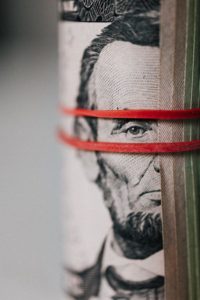Hey there folks! Andrew Bloom of Disciplined FX, here, where you can find resources to help build your trading mindset, trade mechanical strategies, and learn how to achieve profitability in forex markets!
For those who don’t know my story, I started teaching myself how to day trade after developing a chronic illness that left me unable to reliably show up to work or to live independently.
By developing the skill of day trading with technical analysis, I was able to finally acquire an income that didn’t require more than a handful of hours of concentrating on the charts each week.
Furthermore, some of you may know just how expensive healthcare is, especially if doctors aren’t sure what’s wrong.
By making use of the opportunities available through developing trading skills, I now have the resources to afford top-notch medical care and to be able to live on my own again.
Whether we like it or not, we live in a world where having more money means having more options.
So now I want to be able to help you all develop your trading skills so that you can finally afford a better life that lets you achieve goals and dreams that may break the status quo and perhaps relieve you of any financial burdens that keep you struggling to live your best life.
With that said, I want to spend today talking about the style of trading I used to achieve not only profitability in current markets, but also to pass the FTMO prop trading challenge.
Mechanical Trading
I am what some may call a “mechanical trader”. While there isn’t necessarily a firm definition for what this entails, I’m labeling my trading style as mechanical because every step of the strategies I use has very clear and strict rules about what I can and cannot do during a trade.
 Mechanical strategies are like machines that run a protocol of actions, such as with a pinball machine that uses levers to flick the ball back up towards the holes on the board, where you can trust that when you press the buttons on the side of the machine, those levels that they’re attached to will always flick the ball up without fail, so long as you time it right.
Mechanical strategies are like machines that run a protocol of actions, such as with a pinball machine that uses levers to flick the ball back up towards the holes on the board, where you can trust that when you press the buttons on the side of the machine, those levels that they’re attached to will always flick the ball up without fail, so long as you time it right.
The pinball might not land in a winning hole, but the mechanics of your actions do not change often and overall stay fairly consistent.
A rules-based, mechanical strategy is similar to the pinball machine.
In this way, your strategy becomes a habit that is easier to perform the more often you do it. As long as a mechanical strategy is profitable, the rules don’t change and likely don’t allow for much room to make your own interpretations.
Mechanical strategies usually have a set of rules for when you can and can’t enter, for where you set your stop loss and take profit targets, and often these strategies will rely upon chart indicators, like moving averages or an RSI, to help pinpoint these locations.
When you hear about expert advisors and programmable trades, those are likely a form of mechanical strategy.
If you want an example of a mechanical strategy, check out the free scalping strategy I created. While this strategy isn’t robust enough for a prop trading challenge, it is a nice addition to a set of other types of strategies and styles.
What I like best about mechanical strategies is that they take the pressure off of having to analyze and decide what the current market is doing.
Instead, the focus of your role as the trader is to follow your rules with discipline.
How do you know if you have a good trade? It’s easy, when you trade your rules, you are trading well, even if you lose from time to time. It’s when you make impulsive decisions intratrade that problems arise.
Another reason why I love mechanical strategies is that they are far easier to backtest than strategies that require discretionary decision-making.
With discretionary decision-making, you don’t always know what is forming until the aftermath. If you look at historical data through a backtest, it’s likely you’ll call the candle formations in favor of their final form, but in real-time, your fears and concerns may prevent you from reading the formation right.
With a mechanical strategy, you have very clear yes or no answers from historical data as to whether the strategy worked on a given day.
That way, you are able to get an idea as to how profitable the strategy is and get to gather other information such as how frequently you experience strings of losses and for how long they tend to last.
Such information can be useful when deciding on risk management strategies.
How To Craft Your Own Mechanical Strategy
So, before I end this lesson, I want to show you how you can craft your own mechanical strategy over a few easy steps.
It’s not the only way to create a strategy, but it’s a good overview of the things I personally consider when I need to craft a new strategy, such as the one I used to pass the FTMO challenge.
**By the way, if you want to use the exact strategy I am running for my prop trading, check out the Disciplined FX Scalping Course**
1) Determine Your Trading Requirements
Do you want to be trading an hourly chart?
Do you want to scalp and be in and out of a trade within an hour or two?
Do you need a strategy that lets you trade at night since you work during the day?
I’ve come to find that if you set the boundaries of your trading to what your schedule, skill, and comfort level are, you’re more likely to stick with a strategy, than for instance, if you forced yourself to watch the charts six hours a day, every day, with no clear direction as to what you’re looking for.
So here are some things that I like to look for before establishing a mechanical strategy:
- I want to trade lower time frames so I don’t have to keep trades open for a long time, thus I look to the 30m, 15m, or 5m charts.
- I live in Southern California and consider myself a morning person, so I’m most interested in trading during the cross-over of the London and NYC markets, around 630am PST.
- Lastly, I don’t want to spend more than a handful of hours in front of the charts each week, since I need a lot of time to take care of my health and other responsibilities – such as studying for my doctorate level courses and creating informative content for my students.
Thus, I like strategies that don’t require any complicated exiting maneuvers, such as trailing stops with position reduction, and I only want to take one trade a day, so that I can get in, let my attached stop loss and take profit orders do the work, and then get to work or go back to bed if my energy is low.
2) Determine your Edge
This can look like only trading trends or trading around scheduled economic news. Research trading edges to find out more.
3) Pick your Pair(s) and Trading Time
Now, after creating your own parameters for your trading session, you’ll want to select a currency pair or pairs that fit these needs.
I currently only trade the EUR/USD and find that focusing on one currency pair helps me get a really good feel for the typical behavior of that market, but you’re also welcome to trade multiple currency pairs as long as you backtest for each one.
One thing to consider when looking for a pair is that it’s best to trade a pair that has at least one underlying market open, not closed, during the time you trade.
So if you’re in the Caribbean and you’re looking to trade in the evening you might want to look at trading a pair that has the AUD, NZD, or JPY, as those markets will just be getting started for the day.
4) Select Your Indicators or Signals
Next, pick an indicator or two that supports the market-style you want to trade – for example, if you’re looking to trade trends, a moving average plus an indicator that helps track trends can be useful, such as the ADX or MACD.
5) Formulate Your Mechanical Strategy
The next step is where you really need to get creative.
You want to be able to create a set of rules around your chosen indicators and price that help tell you when it’s a good time to get into the market, in what direction you want to trade (buy/sell), and where to put your stop loss and target profit.
This could mean entering when price returns to a moving average and then trading in the direction of the trend.
I find it really useful to call on any previous strategies you’ve used before or seen in videos to help get an idea of what indicators to implement.
Again, check out the free scalping strategy I created for an example of what this could look like.
When it comes to stop loss and take profit targets, try to get a feel for the typical number of pips that move over the span of your time frame during your trading hours or create a formula for determining appropriate stop loss and take profit targets as adjusted for the current market behavior.
One indicator I love to use for this is the ATR, or average true range.
Making a stop loss that is equal to or a factor of the ATR can be useful, such as making a stop loss that is 1.5x the current ATR reading.
Lastly, depending on your strategy, be sure to include any other rules, such as how long you let a trade run, like opting to close the trade after six hours, or rules for when you stay out of the markets altogether, such as when the price is ranging.
Using something like the ADX, which tracks trend strength, may be useful to include.
If trying to craft your own strategy is still feeling overwhelming, I invite you to use the same strategy that I trade with to win and profit from prop trading challenges.
 That summarizes my approach to crafting mechanical day trading strategies. I hope you’ve been able to discover just how organized and useful a mechanical strategy can be, especially when you want to achieve clarity and minimize confusion while trading.
That summarizes my approach to crafting mechanical day trading strategies. I hope you’ve been able to discover just how organized and useful a mechanical strategy can be, especially when you want to achieve clarity and minimize confusion while trading.
I wish you all the best of strength and luck out there in the markets!





 #3) The FX market can be a bit more stable than the kinds of stocks most beginners can afford to trade.
#3) The FX market can be a bit more stable than the kinds of stocks most beginners can afford to trade. 



 Perhaps when you first started to learn to trade, you looked around Youtube and the rest of the internet and saw different people talking about how they make a living off of trading. Whether it was the flashy cars or the nice desks and houses, or even screenshots of account sizes, something told you overall that this person has reached success and if they can do it, so can you. That’s okay, it’s an empowering feeling to be inspired by the success of others. But sometimes this can lead us to have unrealistic expectations.
Perhaps when you first started to learn to trade, you looked around Youtube and the rest of the internet and saw different people talking about how they make a living off of trading. Whether it was the flashy cars or the nice desks and houses, or even screenshots of account sizes, something told you overall that this person has reached success and if they can do it, so can you. That’s okay, it’s an empowering feeling to be inspired by the success of others. But sometimes this can lead us to have unrealistic expectations.
Latest posts